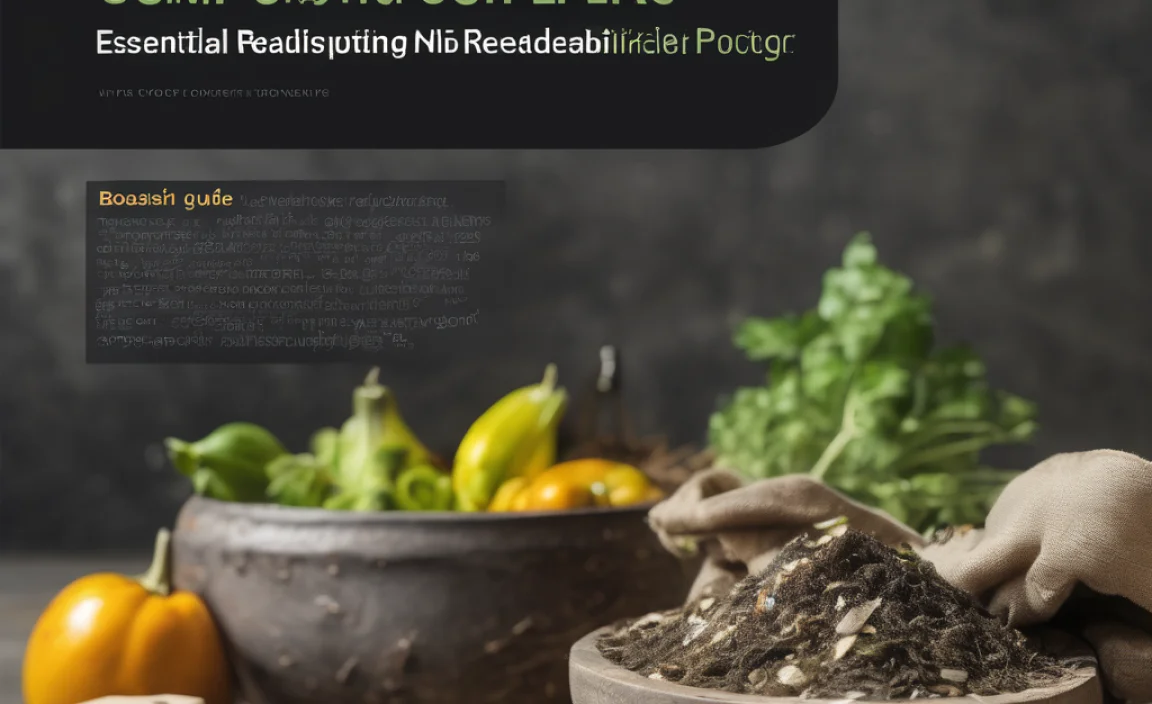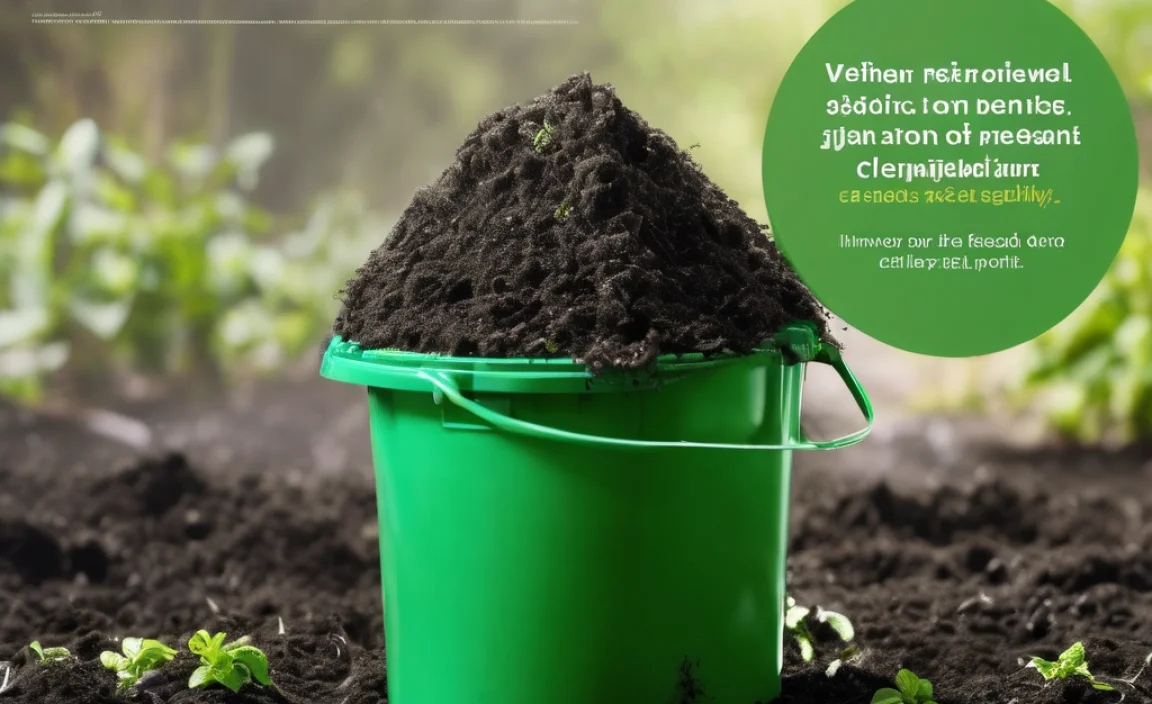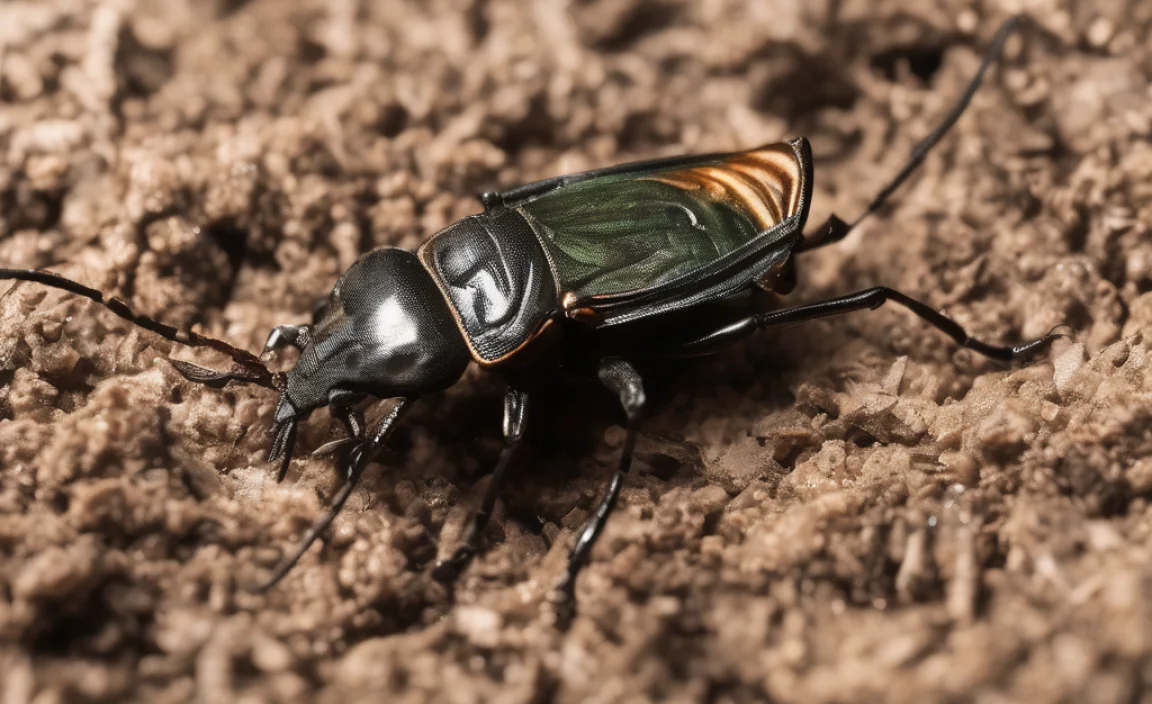Ever tossed kitchen scraps into a compost bag and wondered, “Is this even working?” You’re not alone! Getting compost right can feel like a science experiment, especially when it comes to temperature. But don’t worry, it’s much simpler than you think. We’ll break down the secrets to perfect compost bag temperatures so you can turn waste into garden gold. Get ready to impress your plants!
Compost Bags Temperature: Genius Essential Insights
Picking up composting can feel a bit like learning a new language. One of the most common questions, especially for beginners using compost bags, is about temperature. “What temperature should my compost bag be?” “How do I even check it?” These are great questions, and the answers are key to making your compost system work efficiently. Let’s dive into the fascinating world of compost bag temperatures and unlock the secrets to turning your kitchen and yard waste into nutrient-rich soil.
Composting is a natural process where organic materials decompose. When done correctly, it creates a fantastic fertilizer for your garden, reducing waste and saving money. Compost bags are a popular choice for many home composters because they’re compact, manageable, and relatively tidy. But to get the most out of them, understanding the role of temperature is crucial.
Why Does Compost Bag Temperature Matter?
Think of temperature as the “engine” of your compost pile. Microorganisms, like bacteria and fungi, are the workers that break down your organic matter. These tiny helpers thrive within specific temperature ranges. When the conditions are right, they work faster and more effectively. This means:
- Faster Decomposition: A hot compost pile breaks down materials much quicker than a cold one.
- Natural Sterilization: Higher temperatures (above 131°F or 55°C) can kill weed seeds and pathogens, making your compost safer and more beneficial for your garden. This is often referred to as “hot composting.”
- Better Odor Control: A well-managed, actively heating compost pile tends to have fewer unpleasant smells because the beneficial microbes are outcompeting the odor-producing ones.
- More Nutrients: Efficient decomposition preserves more valuable nutrients in the finished compost.
While you don’t need to be obsessive about precision, knowing the ideal temperature range helps you understand if your compost is actively working or if it needs a little attention. For compost bags, which are typically smaller than a traditional pile, achieving and maintaining optimal temperatures can be a bit trickier but certainly achievable.
Understanding the Different Stages of Compost Temperature
Compost piles, including those in bags, go through different thermal phases as the decomposition process progresses. Understanding these phases can help you troubleshoot and manage your compost effectively.
The Cold to Mesophilic Phase (Below 113°F / 45°C)
This is the initial stage. When you first add your ingredients to the compost bag, the microbial activity is relatively low. Temperatures will be close to the ambient air temperature. Mesophilic bacteria are the main players here. They start breaking down the readily available sugars and starches in your food scraps and yard waste.
The Thermophilic or “Hot” Phase (113°F – 160°F / 45°C – 71°C)
As the mesophilic bacteria work, they generate heat. If you have the right mix of “greens” (nitrogen-rich materials like food scraps and grass clippings) and “browns” (carbon-rich materials like dry leaves and shredded paper), and enough moisture and aeration, the temperature will start to climb rapidly. This is the “hot composting” phase. Thermophilic microorganisms take over. This is where the magic happens quickly, killing most weed seeds and pathogens.
The Cooling Down Phase
If your compost pile has reached its peak “hot” temperature, it will eventually start to cool down. This happens as the easily digestible materials are consumed. The temperature will drop back to the mesophilic range and then to ambient temperatures. This phase is crucial for curing the compost. Fungi, actinomycetes, and worms (if they’re present) become more active, breaking down tougher materials like woody bits and continuing the curing process.
Ideal Temperature Range for Compost Bags
For most home composting with bags, you’re aiming to get your compost hot enough to break things down efficiently but not so hot that you kill off the beneficial microbes. The sweet spot for active, effective composting is generally between 130°F and 160°F (55°C to 71°C).
Why this range?
- 130°F (55°C): This is often considered the minimum temperature for significant pathogen and weed seed kill. It indicates active decomposition.
- 160°F (71°C): Reaching this temperature means your compost is working hard! However, prolonged temperatures above 160°F can harm beneficial microbes and slow down the process. It’s also harder to maintain in smaller compost systems like bags.
If your compost bag stays below 100°F (38°C) for an extended period, it’s likely not decomposing very quickly. If it consistently stays around 120°F-130°F (49°C-55°C), it’s still composting, just at a slower, “warm” rate, which is perfectly fine for many home gardeners. The key is to encourage activity.
How to Measure Compost Bag Temperature
You don’t need a fancy degree in microbiology to check your compost’s temperature. Several simple tools can help you keep an eye on things:
Compost Thermometer
This is the most straightforward tool. Compost thermometers are long, sturdy probes designed to be inserted into the middle of your compost pile or bag. They allow you to easily read the internal temperature without disturbing the pile too much. Look for one with a dial that clearly shows different temperature zones (e.g., “hot,” “active,” “cool”).
Where to find them: Garden centers, online retailers, and home improvement stores.
Cost: Typically range from $15-$30.
Your Hand
While not precise, your hand can give you a general idea. If the outside of the bag feels warm, the inside is likely hotter. If it’s lukewarm, it’s probably not actively heating up. If it’s cold, it’s definitely not hot composting. This is a good initial check but not a substitute for a thermometer if you’re trying to optimize.
Your Nose
A healthy, working compost pile typically smells earthy, like a forest floor. Foul or ammonia-like odors can indicate an imbalance (too much green material, not enough air, or too wet), which can also affect temperature. While not a direct temperature measurement, it’s a sign of the overall health, which is tied to thermal activity.
Factors Affecting Compost Bag Temperature
Several elements play a role in how hot your compost bag gets. Understanding these can help you influence the temperature:
1. Ingredient Mix (Greens vs. Browns)
This is arguably the most crucial factor for generating heat.
- Greens (Nitrogen-rich): Fruit and vegetable scraps, coffee grounds, tea bags, fresh grass clippings, plant trimmings. These provide the protein and energy for microbes.
- Browns (Carbon-rich): Dry leaves, straw, shredded newspaper or cardboard, twigs, sawdust. These provide the energy source the microbes need and add bulk for aeration.
A good general ratio is about 2-3 parts browns to 1 part greens by volume. Too many greens can lead to a slimy, smelly mess that doesn’t heat up well. Too many browns will slow down decomposition significantly because the microbes don’t have enough nitrogen fuel.
2. Moisture Content
Microbes need moisture to live and work, but they can drown if it’s too wet. Your compost bag should feel like a wrung-out sponge – damp, but not dripping when you squeeze it. If it’s too dry, the microbial activity will slow down (and so will the temperature). If it’s too wet, you’ll reduce airflow, potentially leading to anaerobic (without oxygen) conditions and foul odors, also affecting temperature negatively.
3. Aeration (Oxygen)
Microbes that break down organic matter in a hot compost pile need oxygen. This is why turning or mixing your compost is recommended. For compost bags, aeration can be achieved in a few ways:
- Turning the bag: Some bags are designed to be tumbled or emptied and refilled.
- Stirring: Using a compost aerator tool or even a sturdy stick to poke holes through the material.
- Bag design: Some bags have built-in vents or are made of breathable fabric.
Lack of oxygen leads to slower decomposition and can cause the pile to go anaerobic, producing unpleasant smells and reducing heat.
4. Volume of Material
Compost piles need a certain minimum volume to retain heat effectively. A pile smaller than 3 feet x 3 feet x 3 feet (about 1 cubic yard or 1 cubic meter) can struggle to heat up, especially in cooler weather. Compost bags are inherently smaller, so achieving high temperatures can be more challenging. You’ll need to be diligent with the green-to-brown ratio, moisture, and aeration to maximize heat generation in a smaller volume.
5. Ambient Temperature
The outside air temperature will affect your compost bag’s internal temperature. In colder months, your compost pile will cool down faster and may not reach very high temperatures. In very hot weather, your compost might overheat if not managed carefully, which can kill beneficial microbes.
Troubleshooting Temperature Issues in Compost Bags
Is your compost bag sluggish? Is it not heating up at all, or perhaps too cool?
Scenario 1: My Compost Bag Isn’t Heating Up
This is a common beginner issue. If your thermometer reads consistently below 100°F (38°C), here’s what to check:
- Too Many Browns: Your pile might be too dense with carbon-rich materials. Add more “greens” (nitrogen-rich materials). Aim for that 2-3 parts browns to 1 part greens ratio.
- Too Dry: The microbes need moisture. Add water, mixing it in as thoroughly as possible.
- Needs More Bulk: Smaller compost systems have trouble retaining heat. Try adding more material to increase the volume.
- Lack of Aeration: If the material is compacted, the microbes aren’t getting enough air for efficient decomposition. Stir it up or use a compost aerator.
- Too Cold Outside: In winter, it’s harder to get hot compost. Focus on maintaining a “warm” pile and be patient.
Scenario 2: My Compost Bag is Too Hot (Above 160°F / 71°C)
While excellent for killing pathogens, prolonged temperatures above 160°F can be detrimental. If your thermometer shows excessive heat:
- Too Much Nitrogen (Too Many Greens): Overload of nitrogen can cause overheating. If it smells strongly of ammonia, this is a likely culprit and you need to add more browns.
- Too Wet: Excess moisture can sometimes contribute to overheating. If you suspect it’s too wet, add dry browns and stir to improve aeration and absorb excess water.
- Needs Turning/Aeration: Heat can sometimes be trapped. Aerating the pile can help release some of that heat.
If your compost gets too hot, a good practice is to turn a portion of the hot material into a new pile or bag, mixing it with cooler, unfinished material. This helps regulate the overall temperature.
When to Turn or Aerate Your Compost Bag
For compost bags, the ideal turning frequency depends on your goals. If you’re aiming for hot composting and faster results, you’ll want to turn it more frequently.
- For Hot Composting (Faster Results): Turn or aerate the bag when the temperature starts to drop from its peak (e.g., after 3-7 days in the hot phase). This reintegrates cooler material, reintroduces oxygen, and kickstarts the heating process again.
- For Cooler Composting (Slower Results): If you’re not in a rush and your compost is still decomposing steadily (even if not “hot”), you might only need to aerate or turn it every 2-4 weeks.
For many enclosed compost bags, simply tumbling them or using a compost aerator tool is sufficient. The goal is to ensure oxygen reaches all the material and that trapped heat and moisture are distributed.
Tools for Composting Success
While you can start composting with just a bag and your kitchen scraps, a few tools can make the process much easier and more effective:
- Compost Thermometer: As discussed, this is essential for understanding your compost’s activity.
- Compost Aerator / Turning Tool: A long, pointed tool designed to poke into compost and lift material, introducing air.
- Gloves: To keep your hands clean and protected.
- Pitchfork or Shovel: If you need to turn or move material, especially if emptying the bag.
- Watering Can or Hose: To adjust moisture levels.
- Bucket with Lid: For collecting kitchen scraps before adding them to the main compost bag, reducing odors indoors.
Compost Bag Temperature VS. Traditional Piles
It’s worth noting that compost bags often require a bit more attention to temperature than larger, open compost piles. Why?
- Volume: As mentioned, larger piles naturally insulate themselves better and retain heat more effectively.
- Aeration Control: Open piles can be turned easily with a pitchfork. While compost bags offer contained composting, the method of aeration might be more manual or specific to the bag’s design.
- Moisture Management: Bags can sometimes retain too much moisture, or conversely, dry out more quickly if made of breathable material.
However, the principles remain the same. By understanding the factors that influence temperature – greens, browns, moisture, and air – you can successfully manage your compost bag for optimal results.
The Science Behind the Heat (Simplified!)
At its core, composting is a biological process driven by microorganisms. When you add organic matter, these microbes get to work. They consume the carbon for energy and the nitrogen for protein synthesis. As they multiply and metabolize, they release heat as a byproduct. This is similar to how your own body generates heat through metabolism. The more active the microbial community, and the more readily available food (organic matter) and the right conditions (moisture, oxygen), the more heat they produce. When the temperature gets high enough, they create their own “hot tub” environment, allowing them to thrive and work at their most efficient pace. For more on the science, check out resources from university extension offices like Oregon State University Extension or Yale University’s Sustainability program, which offer detailed insights into composting science and best practices.
A well-managed compost bag that reaches thermophilic temperatures (130°F – 160°F) is a sign that you’ve achieved a good balance of ingredients and conditions. This “hot” phase is crucial for quickly breaking down materials and killing off unwanted pathogens and weed seeds, leading to a cleaner, more effective compost for your garden.
When is Compost Ready? (Heat as an Indicator)
The temperature of your compost bag is a good indicator of its stage of decomposition. A compost pile that has gone through a heating cycle and then cooled down to ambient temperatures, with minimal re-heating after turning, is generally well on its way to being finished. However, temperature alone doesn’t tell the whole story of readiness.
Here are other signs your compost is ready:
- Appearance: The original materials should be unrecognizable. It should look like dark, crumbly soil.
- Texture: It should be uniform and crumbly, with no large chunks of recognizable food scraps or yard waste (except maybe very woody materials, depending on how long it’s been processed).
- Smell: It should smell earthy and pleasant, like a forest floor. Any sour or ammonia-like odors mean it’s not quite ready.
- Temperature: As mentioned, it should be cool or at ambient temperature and stay that way after turning.
If your compost bag has gone through at least one full heating and cooling cycle and meets these criteria, it’s likely ready to use. You can then use it as a soil amendment or mulch.
Quick Summary Table
Here’s a handy reference for compost bag temperature:





